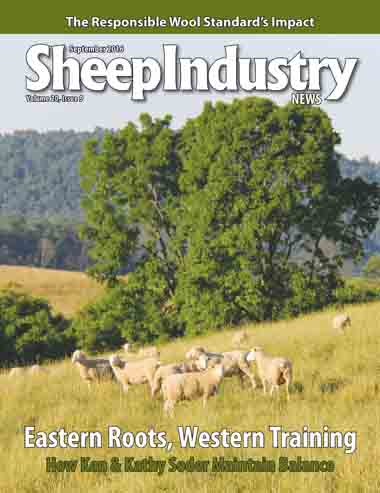
- September 2016
- President’s Notes
- Should Your Wool Be RWS Certified?
- Patagonia Buys American in Wool Restart
- Reporting Rules Show Little Change
- Eastern Roots, Western Training
- Genetic Data Pays Off at Sale Barn
- UK Ovine Genetics Available Again in U.S.
- Polypay Takes on Parasite Study
- Comments Submitted on Uruguay Proposal
- Obituaries
- Market Report
- The Last Word
Should Your Wool Be RWS Certified?
Textile Exchange’s Responsible Wool Standard Could Affect Future American Wool Sales
KYLE PARTAIN
Sheep Industry News Editor
Large-scale American wool producers might benefit from some minor changes proposed by the Textile Exchange’s new Responsible Wool Standard.
While ASI hasn’t officially endorsed the standard that was developed in response to animal welfare issues that occurred in South America in 2015, major outdoor clothing brands seemed generally in favor of the standard during the RWS Brand Training at the Outdoor Retailer Show last month in Salt Lake City.
With that in mind, American wool producers should definitely take some time to learn more about the standard, which was developed in conjunction with many of those same manufacturers.
As the story on the next page suggests, there are both challenges and possible financial benefits that come with meeting the new standard. ASI members Jeanne Carver (Oregon) and Steve Osguthorpe (Utah) were involved in pilot audits of the new standard, and received a premium price for their spring wool from Patagonia for their efforts. Further pilot audits have been or will be conducted with wool producers around the world as the standard starts to take hold.
As clothing lines are developed in the years to come, other brands might very well offer premium prices for wool that meets the demands of the Responsible Wool Standard. With that in mind, here are answers to some basic questions about the RWS.
Q: What’s involved in the audit process?
A: An independent firm (several are expected to be certified by the Textile Exchange) will spend time observing the workings of your ranch. They’ll want to see the lambing and shearing process, for example. Experts will evaluate your land management practices. And there will be lots of paperwork, as virtually everything that happens with your sheep and the land they graze will need to be documented.
“We’ve been doing most of this stuff, it’s just that we never thought to write it down. It was all up here,” Osguthorpe said as he pointed to his head. “They just want to be ahead of the game and have everything documented. It takes some time, but once you get used to doing the paperwork it won’t be that bad.”
Take heart that producers aren’t the only ones undergoing such inspections. For wool to be certified with the RWS seal, every company that touches that wool from the ranch forward will have to go through a certification process. The only company escaping scrutiny is the final retailer, which merely stocks the product for sale.
Q: How much is this going to cost?
A: Producers will pay a fee (estimated at somewhere between $2,500 and $4,000) to be audited. The standard also requires yearly audits, so that’s an annual cost.
Addressing the Utah Wool Growers Association on Aug. 1 in Park City, Utah, Carver said she would like to find grant money to help cover these costs for producers who are interested in the program. But with no grants in place at this time, producers can expect to pay the audit costs out of their own pocket in the foreseeable future.
Q: How will I benefit from being a part of the RWS?
A: The honest answer is you might not. But, there’s reason to believe that you will. Carver and Osguthorpe have already benefitted from getting on board early in the process and selling their wool at a premium (20 to 25 percent higher than usual, according to Osguthorpe). Patagonia bought wool from both producers for a sock line that will be available in the years to come.
The brands represented at the RWS Brand Training in Salt Lake City seemed interested in working with RWS certified wool in an effort to avoid the animal welfare issues that so drastically affected Patagonia in 2015. They realize the wool will be more expensive because of the certification process, but seemed to believe the cost would be less than the type of public relations nightmare Patagonia went through. The company essentially shut down its involvement with wool for half a year to sort out supply chain issues.
One thought that did emerge from the meeting is that there will be a relatively small amount of RWS-certified wool in the first few years of the program. Companies looking to buy such wool in the next two to three years will expect to pay a premium price for the limited quantities.
Keep in mind, however, that not a single brand represented in the meeting committed to buying RWS wool as soon as it is available. Some might choose to follow Patagonia’s lead in developing their own standard in the years to come.
“There are no guarantees,” Carver said. “As producers, we have to see the vision here and work toward it.
“This really didn’t change anything we do with the sheep on the ranch, but it did change the way we keep track of it all. Instead of that tally book that we’ve always used, now we do everything in a spreadsheet that we save on Dropbox, so we all have access to it.”
Does RWS certification make sense for your ranch? Each individual producer will have to answer that question for themselves. To learn more, visit ResponsibleWool.org.

